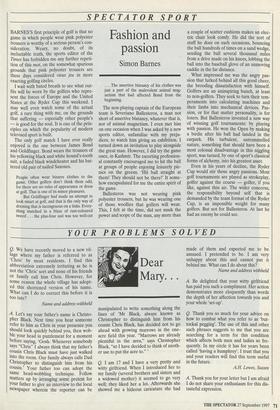SPECTATOR SPORT
Fashion and passion
Simon Barnes
BARNES'S first principle of golf is that no game in which people wear pink polyester trousers is worthy of a serious person's con- sideration. Weary, no doubt, of its ineluctable truth, the sports editor of the Times has forbidden me any further repeti- tion of this mot, on the somewhat spurious grounds that pink polyester trousers are these days considered vieux jeu in more exacting golfing circles. I wait with bated breath to see what out- fits will be worn by the golfers who repre- sent the forces of Europe and the United States at the Ryder Cup this weekend. I may well even watch some of the actual golf, a rare thing with me, on the grounds that suffering — especially other people's — is good for the soul. It is one of the prin- ciples on which the popularity of modern televised sport is built. The only golf match I have ever really enjoyed is the one between James Bond and Goldfinger. Bond wears the trousers of his yellowing black and white hound's-tooth suit, a faded black windcheater and his bat- tered old pair of nailed Saxones.
People often wear bizarre clothes to the game. Other golfers don't think them odd, for there are no rules of appearance or dress at golf. That is one of its minor pleasures.
But Goldfinger had made an attempt to look smart at golf, and that is the only way of dressing that is incongruous on a links. Every- thing matched in a blaze of rust-coloured tweed . . . the plus-four suit was too well-cut . The assertive blatancy of his clothes was just a part of the malevolent animal mag- netism that had affected Bond from the beginning.
The non-playing captain of the European team is Severiano Ballesteros, a man not short of assertive blatancy, whatever that is, nor of animal magnetism. I even met him on one occasion when I was asked by a new sports editor, unfamiliar with my preju- dices, to watch him giving an exhibition. I turned down an invitation to play alongside the great man. However, I did try the game once, in Kashmir. The escorting profession- al constantly encouraged me to hit the ball at groups of people enjoying leisurely pic- nics on the greens. 'Hit ball straight at them! They should not be there!' It some- how encapsulated for me the entire spirit of the game.
Ballesteros was not wearing pink polyester trousers, but he was wearing one of those . woollies that golfers will wear. This, I felt at the time, did not mask the power and scope of the man, any more than a couple of scatter cushions makes an elec- tric chair look comfy. He did the sort of stuff he does on such occasions, bouncing the ball hundreds of times on a sand wedge, sending the ball several thousand miles from a drive made on his knees, lobbing the ball into the baseball glove of an unmoving caddie in the far distance.
What impressed me was the angry pas- sion that lurked behind all this good cheer, the brooding dissatisfaction with himself. Golfers are an uninspiring bunch, at least to non-golfers. They seek to turn their tem- peraments into calculating machines and their limbs into mechanical devices. Pas- sion, or for that matter personality, is for losers. But Ballesteros invented a new way of winning golf tournaments: by playing with passion. He won the Open by making a birdie after his ball had landed in the carpark. His turbulent, untrammelled nature, something that should have been a most colossal disadvantage in this niggling sport, was turned, by one of sport's classical forms of alchemy, into his greatest asset.
Even in his years of decline, the Ryder Cup would stir those angry passions. Most golf tournaments are played as strokeplay, golfer against the course — golfer, if you like, against thin air. The wider concerns, the responsibility beyond self that is demanded by the team format of the Ryder Cup, is an impossible weight for many golfers. But not for Ballesteros. At last he had an enemy he could see.










































































 Previous page
Previous page